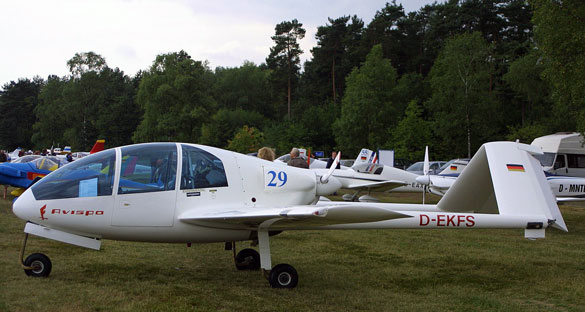
General
The Akaflieg Stuttgart fs28 Avispa is an experimental 2-seat light aircraft with an unusual layout.
last update: 9 May 2006
author: Loet Kuipers
History
The fs28 Avispa is designed and built by the flight research group of the University of Stuttgart, specifically Wolf Hirth and Nabern. The first flight (D-EAKS) was made in December 1972. The aircraft is named "Avispa" after the Spanish word of wasp. It is a purely experimental aircraft; unconventional elements are the twin-boom structure, the pusher propeller and the inverted V-tail. Most of the structure consists of glass fiber composite material.
Main objectives of the design were limitation of sound and vibration. Especially the glass fiber was sensitive to vibrations. the exhaust pipes were placed in such a way that the exhaust gases prevented icing of the propeller. The aircraft was relatively low powered, but gave good performance thanks to its efficient design. The Avispa crashed after an inflight propeller failure. In recent years another fs28 Avispa has been built and is flying, the D-EKFS.
Airframe
wing: cantilever midwing monoplane, dihedral 4.50°, sweepback 4.75°, sandwich stucture of glass fiber and rigid foam, plain ailerons and Fowler flaps, no trim tabs.
fuselage: Nacelle structure of reinforced glass fiber/honeycomb sandwich, with engine at rear; semi-annular air intake between cabin and engine compartment.
tail: Inverted ‘V’ rudder/stabilizer on twin boom, construction as for wings. Elevators fabric covered with spring trim system.
landing gear: retractable tricycle landing gear with a single wheel on each unit. Steerable nosewheel, hydraulic brakes, glass fiber shock absorption units.
Powerplant
- One Lycoming O-235-E2A horizontally-opposed, air-cooled 4-cylinder engine delivering 115 hp (86 kW).
- Engine drives a 3-blade Hoffmann pusher propeller on first aircraft (D-EAKS) and 2-blade constant speed pusher propeller on D-EKFS.
- Total fuel capacity 115 l (30 USG).
Systems
No information available.
Avionics
No information available.
Accommodation
Two seats side-by-side in extensively glazed enclosed cabin. Cabin door on both sides of aircraft.
Armament
N/A
Dimensions
External:# wing span; 9.40 m / 30.84 ft# overall length; 7.20 m / 23.62 ft# wing chord at root; 1.63 m / 5.35 ft# wing chord at tip; 0.80 m / 2.62 ft# tailplane span; 2.40 m / 7.87 ft# wing area; 12.7 sq m / 137 sq ft# aspect ratio; 7.0
Weights & Loads
max. t-o weight; 900 kg / 1984 lbs# empty weight; 640 kg / 1411 lbs# useful load; 260 kg / 573 lbs# wing loading; 71 kg/sq m / 14.5 lb/sq ft# power loading; 7.8 kg/hp / 17.3 lb/hp
Performance
never-exceed speed; 183 kts / 338 km/h# max. speed, S/L; 146 kts / 270 km/h# max. cruise speed; 135 KTAS / 250 km/h# max. range, economy power, ; 540 nm / 1000 km# stall speed, all up; 46 kts / 85 km/h# t-o run; 270 m / 886 ft# landing run; 120 m / 394 ft